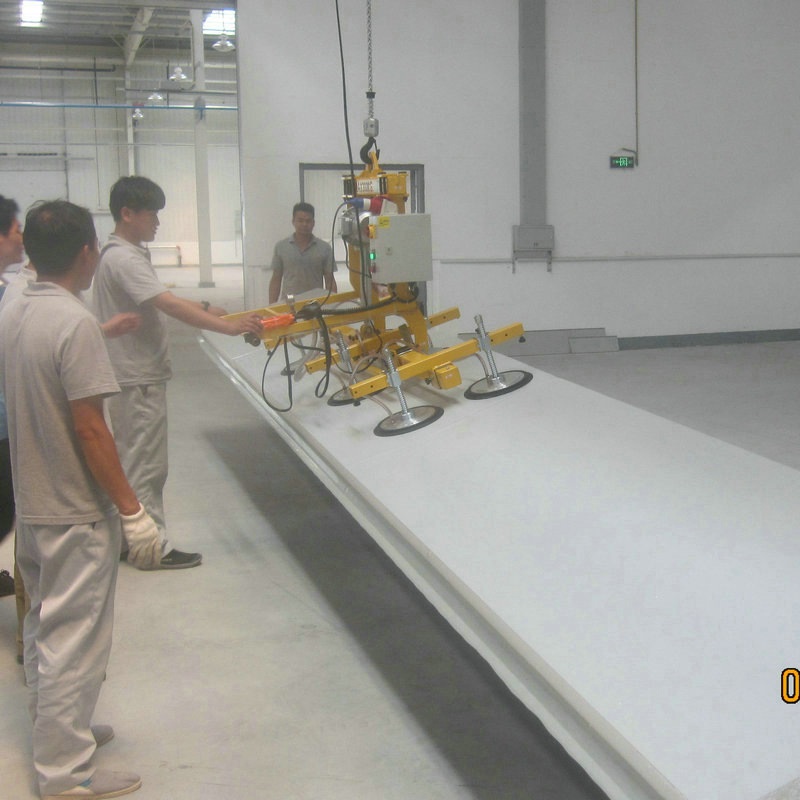
The Load of vacuum stone lifter
The lifting mechanism of vacuum stone lifter is mainly composed of hanging system and winch, and lifts heavy objects through hydraulic system. The operation mechanism of the vertical and horizontal transportation of heavy objects or vacuum stone lifters to adjust the working position, generally by the motor, reducer, brake and wheel. The luffing mechanism is only equipped with the boom vacuum stone lifter, which reduces the amplitude of the arm lifting, increases the amplitude of the drop, and balances and unbalances. The rotating mechanism is used to rotate the arm, which is driven by a driving device and a slewing supporting device. The metal structure is the skeleton of the vacuum stone lifter. The main load-bearing parts such as bridge arm and portal frame, box structure or truss structure, as well as the network structure, some can be used as supporting steel girders.
The characteristics of the vacuum stone lifter operation mechanism are as follows: Generally, there are only four active and driven wheels. If the weight is large, the method of increasing the wheels is often used to reduce the wheel pressure. When the wheels exceed four, the articulated balancing frame device must be used to distribute the load of the vacuum stone lifter evenly on each wheel.
In the course of working, the vacuum stone lifter equipment and its mechanism should overcome the following loads: the vacuum stone lifter load of goods (cargo lifting mechanism and amplitude-changing mechanism by changing cantilever position), friction (some cargo lifting mechanism, horizontal moving mechanism and slewing mechanism of vacuum stone lifter equipment), wind load and snow load (all in dew). Traffic equipment for day work.
These loads are called external loads or static loads, and together with dynamic loads, they form computational loads. The methods for determining static loads are described below and the ways in which they are applied to the driving equipment and its mechanisms are listed.
Load of cargo hoisting mechanism, which can move parts, bulk and liquid cargo vertically and obliquely. Grabbing the finished goods is achieved by binding the wire rope or special lifting gear.
The structure of the wire rope and the binding method of the goods make it possible for the driver to tighten the wire rope in advance and lift the goods smoothly from the base. The situation of using disk to lift is similar to that above. When using rigid hangers to grab goods, the situation is more disadvantageous. At this time, the so-called sudden pull phenomenon often occurs, that is, when the hanger reaches a considerable speed of movement, the goods leave the support. Whatever grabbing method is used, if the driver can't see the cargo, a sudden pull may occur.
When the goods are lifted, the mechanism only needs to overcome a part of the load of the goods, but at the same time it also needs to overcome the friction between the goods and the guide rail. The lifting load of the finished goods is usually known, and the latter can be calculated according to the volume and specific gravity.
Sometimes the lifting mechanism is used to turn over the finished goods. In this case, part of the lifting load of the goods will impact the hoisting wire rope. Bulk and liquid goods are usually transported in some kind of container.
In some cases, the hoisting device itself is used as a container. It should be remembered that the lifting load of bulk and bulk cargo should be determined not according to volume specific gravity, but according to heap specific gravity and taking into account their humidity and bulk density.


- No information
-
1. Design objective of electronic crane scale network management. (1) Adopt advanced distributed data processing techno…
-
Electronic crane scale bearing platform installation to focus Electronic crane scale can be installed generally on the li…


